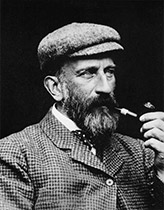Translate this page ►►

Manchester Astronomical Society
Established 1903
Godlee Observatory
Virtual Tour

The Godlee Observatory (and the telescopes therein) was presented to the City of Manchester in 1903 by Francis Godlee. The tower which houses the observatory is a well known landmark to commuters using the nearby Piccadilly Railway Station (although few will realise what the building is used for).
The Godlee double telescope (made by Grubb of Dublin), which has been in regular use since 1903, is rather unusual although the precedent
for this combination had been set 16 years earlier, when Dr Isaac Roberts discussed with Sir Howard Grubb the particular requirements of a large astrographic reflector subsequently erected at Roberts' private observatory at Maghull near Liverpool in April 1885. Here, a 20" Newtonian designed for taking photographs at the prime focus was counter-balanced by a 7" refractor for visual use.

On 10 October 1887 Dr Roberts became the first to photograph the spiral structure of the "Andromeda Nebula" (as the Andromeda Galaxy was referred to, at that time) using this instrument. The observatory was later moved to Crowborough, Sussex, from where, in 1893, Roberts published his important 'Photographs of Stars, Star Clusters and Nebulae'.
cont'd...
2
Since 1946, members have had
free access to the observatory which is equipped with an 8" refractor, counter-balanced by a 12" Newtonian reflector. The refractor is used mostly to view the moon and brighter objects, including the Sun projected as a 15" disk onto a screen fastened to the tailpiece. Unfortunately, the location of the observatory,
close to the city centre, no longer permits good views of deep-sky objects - if, indeed, it ever did.
The Godlee telescopes could therefore be regarded as a tried and tested combination in which the City, members of the branch and, indeed, Sir Howard could have every confidence.
The ancillary 6" f/6 plate camera mounted on the refractor was an obvious choice for wide field photography, particularly for mapping starfields and for comets. Again there were precedents in the large number of short focal length astrographic lenses of similar
aperture in use at the time in America, some of which had been supplied by Sir Howard after trial and error designs had been tested at Greenwich.
The meeting rooms are on floor G of the Sackville Street Building, University of Manchester. They are situated directly under the
observatory which is accessed via a spiral staircase climbing up past the massive telescope pier supported by immense steel I-beams that span the observatory tower.
cont'd...
3
The main high-ceiling Octagon room, with its superb views across the city from the tall windows in six of its eight walls, houses the meeting room equipped with projection screen and digital projector/PC. The Octagon room is an open forum for informal discussions every Thursday evening throughout the year (except the winter session lecture evenings currently held at the MMU in the John Dalton Building and the Christmas/New Year break) where groups of like-minded people can talk about current astronomical topics and events. It has also been used occasionally for meetings of NWGAS and others.It was also the room used for telescope making classes. Mirror making was a popular activity thanks to Mr Steve Hodgkinson and complete telescopes were constructed for subsequent loan to members of the Society. Several members assembled electronically controlled, Scotch-type camera drives for wide field astrophotography.
The library, which contains a large collection
of astronomical reference books (some dating back to the 19th century) and journals, is located in the Annexe room to the rear. The MAS are fortunate in possessing a complete set of Journals of the British Astronomical Association dating from 1890. The library also includes several books presented to the Society by their authors.
All images © MAS

